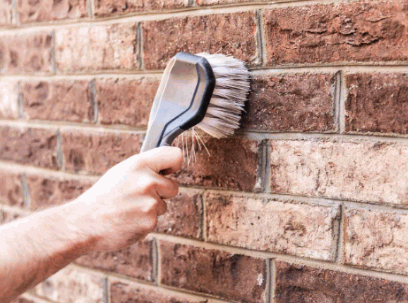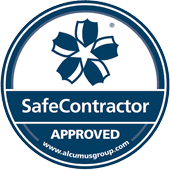Brickwork adds a timeless charm to any home or building, but over time, exposure to the elements, pollution, and general wear and tear can make it look unsightly. This can include the accumulation of dirt and grime, moss and mildew, or even graffiti. However, cleaning bricks isn't as simple as for other surfaces. It requires an understanding of the type of brick, stain, and the best cleaning technique for the specific situation. Read on for our how-to guide for cleaning brickwork.
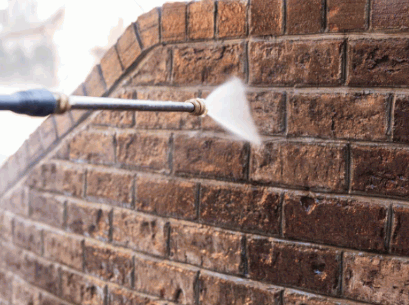
Brickwork comes in a variety of forms, and their exact composition will impact the cleaning solution and process needed. In this guide, we will focus on the most common type of brick - clay bricks.
Clay bricks, also known as traditional bricks, are usually red or brown, and are made from clay that has been moulded and fired in a kiln.
This type of brick has been used for thousands of years, and is known for being tough and durable, but this reputation can be deceptive when it comes to cleaning. Clay bricks are porous, which means that they absorb a lot of water.
Because of this, too much water saturation through using methods like high-pressure washing can lead to water ingress if done incorrectly, which can cause damage to the interior brick. A professional service can often be the best course of action to avoid damaging the brick, especially if it is older.
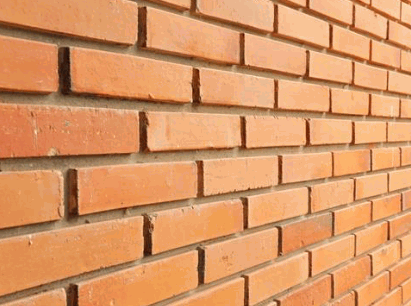
Before cleaning the brick surface, there are a few preparation steps that need to be taken. This is important because it helps to ensure that you are approaching the cleaning process with the proper technique, and that you are keeping yourself safe.
Cleaning can seem like a very safe activity. After all, we all clean a variety of surfaces in our homes every day, and nothing happens. Cleaning bricks, however, can be more dangerous than it seems.
Depending on the type of stain, removing it can result in toxic fumes being released into the air. Similarly, some cleaning solutions can be toxic when inhaled or when they touch the skin.
Always clean brickwork in a well-ventilated area, and ensure you are wearing the proper personal protective equipment (PPE), such as chemical-resistant gloves, respirator, and eye goggles.
While at first glance, many types of stains can look very similar, it is important to identify exactly what they are. Depending on the cause of the stain, very different approaches will be needed. Some cleaning methods that will remove one type of stain can cause another type of stain to set in permanently or cause damage to the underlying brick.
We'll go through some examples of the most common stains you are likely to see on brickwork.
General dirt and grime are likely to build up on exterior brick walls simply due to it being thrown up by wind, passing vehicles, etc. It looks unsightly on the surface of the brick, but it doesn't cause any deeper damage.
Brick cleaning for dirt and grime is a simple process.
A simple solution of water and detergent is enough to remove dirt and grime from a brick wall. Gently scrub using a nylon brush to remove the stains, and then rinse with clean warm water.
Avoid cleaning in direct sunlight as this will make the brick dry out too quickly. You should also avoid cleaning during very cold weather, as this could cause the water that has been absorbed into the brick to freeze.
Don't use a wire brush, as this can damage the surface of the brick. A high-pressure washer is an effective method of removing dirt, but it can damage brick surfaces if used incorrectly, and is often best left to professionals.
Organic growth like moss, mildew, lichen, and algae can grow on brickwork, and this can be a seasonal problem that you notice most during specific times of the year. You may also see larger plants like ivy growing up your brick wall.
If it is a seasonal issue, then the growth will naturally go away once the season is over, but there can still be good reasons to remove it. One of the main issues with organic growth is that it will trap moisture in the brick, which can leave it vulnerable to the freeze-thaw cycle.
For larger plants like ivy, the roots themselves can become embedded in the brick, which can cause structural problems.

Start off with dry removal. This will involve using a stiff brush, or a trowel for tougher plants, to scrub and remove them from the brick wall. Once all of the loose organic growth has been removed, you should apply an algaecide or biocide to kill the plant and prevent it from regrowing.
Professional pressure washing is also effective at removing organic growth from a brick or masonry wall.
Ivy removal is more of a problem. If it is embedded into the exterior bricks, pulling it out can cause damage. This is usually a situation that will require a professional eye.
Brick paint removal is the bane of maintaining exterior walls. It is notoriously difficult to remove for a few reasons. First, it seeps into the pores of the bricks, becoming deeply embedded. This means that it is not simply sitting on the surface like it would on other surface materials.
Second, some paint types (especially those designed for exterior use) are designed to be durable and difficult to remove. This tends to be oil-based paints or acrylic paint (the most common type used in graffiti).
Third, protecting the brick needs to be a priority. It is no use having clean bricks that are free of paint if the brick surfaces or structures have been damaged in the process.
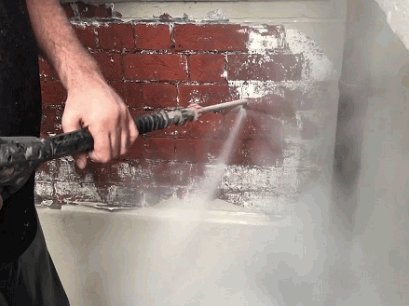
The approach will depend on whether the paint is still wet or if it has already dried.
For wet paint removal, the first thing you will need to do is try to soak up as much of the wet paint as possible without smearing it into a larger area. You can achieve this by taking a clean cloth or paper towel and blotting the paint, not wiping.
Once you have dabbed off as much of the paint as you can, use a damp sponge with clean water or potentially a mild detergent solution. Blot the area again, absorbing as much of the wet paint as possible.
If the paint is oil-based, it won't come off with water alone, and you will need to use mineral spirits, turpentine, or paint thinner.
For paint that is already dry, you should use a trowel to carefully scrape off as much of the surface paint as you can, without damaging the brick underneath. Then use a paint remover to take off the paint. If there are multiple layers, you may need different types of paint remover, depending on the composition of each layer of paint.
A professional pressure washing service can also be effective at removing paint.
Brick tinting is often needed after paint removal to get the brick walls back to their natural colour.
For more details check out our post "How to remove paint from brick".
Efflorescence is white salt deposits that appear on the surface of the brick, although they can sometimes look brown, green, or yellowish.
When salty water is absorbed into the brick, it can leave deposits of salt as the water evaporates.
Efflorescence can happen if the bricks are wet during the construction process or after a particularly wet season. It is harmless and doesn't cause any damage to the underlying brick, and will usually go away on its own with time. But there are ways that you can speed up the process if you want clean brick walls sooner.
Get in-depth information in our post "Why does brickwork go white".
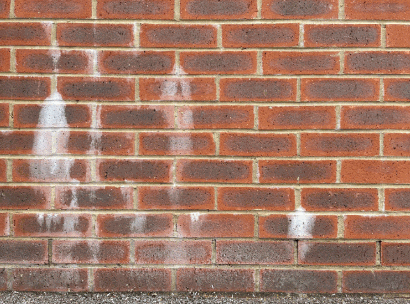
Cleaning the salt deposits away with a dry brush can often be effective. If there is still white remaining, you can simulate gentle rain using a garden hose.
Avoid using abrasive cleaning methods. They aren't necessary and you risk damaging the brick's surface necessarily. You should also avoid using a pressure washer yourself as this risks saturating the brick further, causing even more salt deposits to appear, but professional pressure washing may help.
Smoke and soot can stain brick, and this can be seen externally around chimneys or on interior brick surrounding a fireplace. Over time, the smoke and soot deposits can discolour the brick.
This type of stain can be difficult to remove because it is greasy.
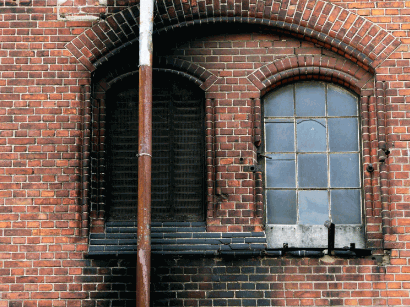
When cleaning interior brick it is important to ensure that there is proper ventilation, especially if there will be soot flying up in the air or if you are using cleaning chemicals.
First, remove loose from the clay brickwork using a soft bristle brush, and then vacuum it up. For any remaining superficial soot, a mild detergent solution in a spray bottle and a damp cloth will usually be enough to remove it.
If, however, the soot has created more stubborn stains, you may have to use additional methods. You can try creating a baking soda paste by mixing four tablespoons of baking soda with 60ml of water. Apply the paste to the soot and use a stiff brush to scrub it in. Then clean with a mild detergent and water.
You can also pick up some specialist soot removal degreaser, which can be more effective at removing greasy soot stains.
Not all metallic stains are equal, and different types of metal will cause specific staining that needs specific solutions.
Iron creates an orange-coloured rust stain that occurs due to oxidization, which is when the iron is exposed to water and oxygen. Manganese causes staining in the same way, but it results in a darker brown or black stain.
Vanadium is also a metal but it stains brick surfaces through a different process that is more similar to efflorescence. Vanadium salts are brought to the surface of the brick through evaporation where they crystallise and cause stains. These tend to be yellow or green and can be mistaken for organic growth.
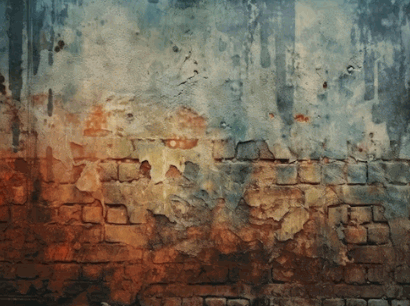
Staining caused by iron or manganese can be removed using hydrochloric acid-based cleaners, such as a toilet cleaner. Pour it onto the rust stain and let it sit for five minutes, then wipe clean with a damp cloth or towel.
You should never use hydrochloric acid on a vanadium stain because it will permanently set the stain to a much darker colour.
Instead, you should use a proprietary vanadium cleaning solution or an oxalic acid cleaner. Dilute the oxalic acid, brush the solution onto the stain, and then apply a washing soda solution once the stain is bleached.
Muriatic acid is effective at removing rust, but it is a chemical that should be used with great caution. It is a strong acid and is hazardous to human health. Contact with the eyes can cause serious eye damage and skin contact can cause severe burns. It can also dissolve the outer surface of the brick and eat away at mortar joints. This is an acid that is often best handled by professionals.
A professional pressure washing service can also be effective at removing rust stains.
There are several reasons why a professional cleaning company, like London Power Washing Team.
We have the knowledge, training, and experience to understand different brick types and stain types, and the best approaches to take for cleaning them. Using the wrong technique can damage the bricks or make the stain worse.
We have access to professional quality cleaning equipment and products that are better able to clean stains from interior and exterior brick walls without causing any damage.
Brick cleaning is not without its hazards, but our team is fully trained in how to handle all types of brick cleaning using the proper health and safety precautions. This ensures that we, and you, are kept safe during and after the cleaning process.
Cleaning stains from a brick wall can be more complicated than it seems. Depending on what has produced the stain, a very different cleaning approach may be needed. If you have any doubt at all about what could be causing the stain, or if the cleaning method may be harmful to yourself or the bricks, it is usually best to bring in some professional help.
